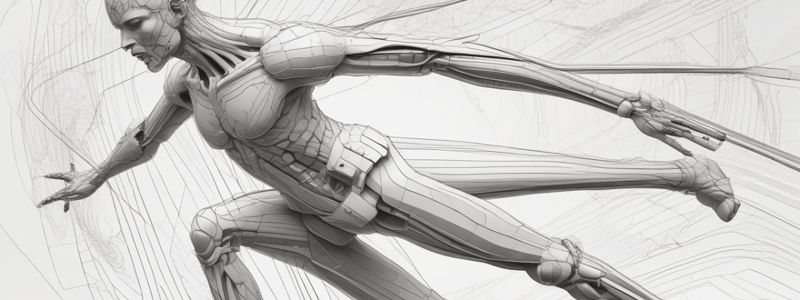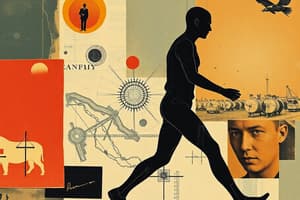Podcast
Questions and Answers
What is the centre of mass, and how is it defined?
What is the centre of mass, and how is it defined?
The centre of mass is the point at which all weight is evenly distributed.
Where is the centre of mass typically located in the anatomical position?
Where is the centre of mass typically located in the anatomical position?
Around the navel.
How does the centre of mass change when the body position changes?
How does the centre of mass change when the body position changes?
The centre of mass also changes as the body position changes.
What is the line of gravity, and what direction does it run?
What is the line of gravity, and what direction does it run?
What is the base of support, and how does it relate to points of contact?
What is the base of support, and how does it relate to points of contact?
Why is it essential to consider the centre of mass and stability in physical activities?
Why is it essential to consider the centre of mass and stability in physical activities?
How does the centre of mass change when a performer moves significant amounts of mass forward?
How does the centre of mass change when a performer moves significant amounts of mass forward?
Why is it important to consider the centre of mass in different body positions?
Why is it important to consider the centre of mass in different body positions?
What is the principle of balance that states that if your line of gravity falls within your base of support, stability is increased?
What is the principle of balance that states that if your line of gravity falls within your base of support, stability is increased?
What is the benefit of having multiple points of contact according to the principle of balance?
What is the benefit of having multiple points of contact according to the principle of balance?
Why does the tackler aim to put their hands behind the opponent's knees?
Why does the tackler aim to put their hands behind the opponent's knees?
How does the width of the base of support affect balance?
How does the width of the base of support affect balance?
What is the advantage of having a lower center of mass?
What is the advantage of having a lower center of mass?
Why do coaches encourage the tackler to get 'eyes to thighs'?
Why do coaches encourage the tackler to get 'eyes to thighs'?
How does mass affect stability?
How does mass affect stability?
What is the advantage of having a wider base of support in a tackling situation?
What is the advantage of having a wider base of support in a tackling situation?
What is the result of an opponent having only one point of contact and a narrow base of support?
What is the result of an opponent having only one point of contact and a narrow base of support?
Flashcards are hidden until you start studying
Study Notes
Centre of Mass (CoM)
- CoM is the point where weight is evenly distributed across an object.
- CoM is not a fixed point; its location varies based on body position, especially in movement.
- For a human in anatomical position, the CoM is typically around the navel.
- Women generally have a slightly lower CoM compared to men.
Locating the Centre of Mass
- Changes in body position alter the CoM location.
- In weightlifting, as weights are lifted overhead, the CoM rises due to the increased weight above the body.
- When a performer shifts mass forward (e.g., extending arms or legs), the CoM also shifts forward, potentially moving outside the body's physical boundaries.
Terminology
- Line of Gravity: Vertical line extending from the CoM straight down to the ground.
- Base of Support (BoS): Area covered by the points of contact with the ground.
- Points of Contact (PoC): Number of body parts in contact with the surface area.
Principles of Stability
- A line of gravity within the BoS enhances stability.
- More points of contact generally improve balance.
- Coaching strategies in sports like rugby emphasize lowering the opponent's points of contact (e.g., tackling at the knees) to reduce their stability.
Factors Influencing Balance and Stability
- A wider BoS increases balance, while a narrow BoS decreases it.
- Lowering the CoM boosts stability; coaching tips include getting "eyes to thighs" to encourage a lower position.
- A greater mass enhances stability by providing resistance against external forces, though mass isn't the sole determinant in outcomes like tackles in rugby.
Studying That Suits You
Use AI to generate personalized quizzes and flashcards to suit your learning preferences.




